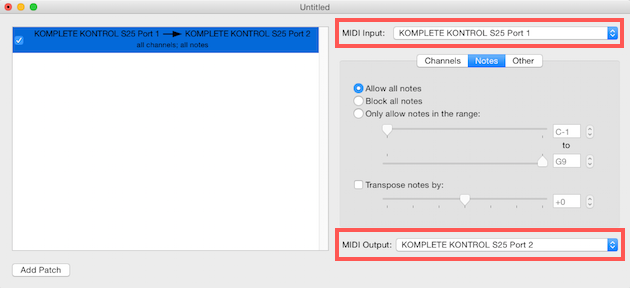

- 16 CHANNEL MIDI PATCHBAY MANUAL
- 16 CHANNEL MIDI PATCHBAY PATCH
- 16 CHANNEL MIDI PATCHBAY PROFESSIONAL
- 16 CHANNEL MIDI PATCHBAY SERIES
The TT/Bantam plugs share the PO316 design but are smaller in diameter (4.4mm). Where space is at a premium, notably when the setup involves a large‑format console and lots of analogue hardware, a reduced‑scale alternative is often employed: the TT (Tiny Telephone) or Bantam format. Professional‑quality longframe patchbays are expensive, though, and usually have to be professionally hand‑wired into the studio installation. headphone jack) by its small‑diameter rounded tip. It’s easily distinguishable from the more common but less robust A‑gauge TRS jack (ie.
16 CHANNEL MIDI PATCHBAY MANUAL
This extremely robust design was developed for manual telephone exchanges, and uses a distinctive ‘PO316’ quarter‑inch (6.35mm) brass plug with three contacts (tip, ring and sleeve).
16 CHANNEL MIDI PATCHBAY PROFESSIONAL
They’re also a much more robust option, so can be good if you plan on doing lots of patching regularly.For patching balanced analogue audio, professional studios have traditionally employed B‑gauge or ‘longframe’ patchbays. The professional Bantam (pictured) and larger B‑gauge plugs are rounded at the end, unlike the consumer TRS jacks most of us are now more familiar with. But this is not an absolute rule: if a situation requires a different arrangement just make sure it’s clearly identified so that everyone can see what’s going on. Usually, sources (equipment outputs) are presented along the top row, and destinations (equipment inputs) are on the bottom row. A complete studio installation might involve several separate patchbays, but each unit typically comprises two rows of sockets.
16 CHANNEL MIDI PATCHBAY PATCH
You insert patch cables in sockets on the front, to route signals between the different devices you’ve connected at the rear. But a patchbay is actually really simple: it’s nothing more than a manual routing matrix.

EssentialsĬhoosing and configuring a patchbay might seem daunting to anyone who’s not done it before, given the various physical formats and the notion that ‘normalling’ might be complicated. I’ll also consider some of the possibilities and benefits of using them in a modern project studio. And they save you having to scrabble around in the dark, under a desk or at the back of a rack! In this article, I’ll take you through the essentials of planning and setting up a patchbay. They come into their own whenever there’s a disparity between the numbers of sources and destinations, and they’re also helpful when you want to establish a default signal path that you’ll only need to change from time to time. It’s understandable: many of us now don’t use mixing desks, we use a fraction of the outboard gear we once did, and audio interfaces can now offer enough connectivity that dedicating inputs and outputs to different hardware devices - so they can be accessed directly from your DAW - is possible for all of us.īut patchbays remain very useful. With so much of what we do today carried out ‘in the box’, the humble patchbay is growing rarer outside of professional studios. Last but not least, 65 patch positions result from the provided matrix, offering users a wide range of possibilities.Even in today’s computer‑based studios, a patchbay can change your life.
16 CHANNEL MIDI PATCHBAY SERIES
Offering a visual analog of a physical controller, MIDI Patchbay is equipped with a series of 16 controls, 8 for the inputs and 8 for the outputs, as well as dedicated commands for controlling pitch, magnitude, and other relevant parameters. Furthermore, through the mapping process, users will basically route the signal to the application’s actual, internal input, and outputs. MIDI Patchbay is a specialized application that was developed specifically in order to provide users with a series of tools for working with the signal to and from their MIDI device, through means of splitting, merging, or applying filters, in accordance to their characteristic requirements.īuilt around an 8 by 8 MIDI interface, the controller will allow one to map all MIDI ports, regardless if we’re talking about the virtual or actual, physical ones, on the audio equipment. Not to mention the hassle of adequately linking the same signal traces to any accompanying software, in order to achieve better control over the physical equipment. Working with MIDI controllers on multiple channels can pose serious challenges, especially when it comes to splitting or merging the signal.


 0 kommentar(er)
0 kommentar(er)
